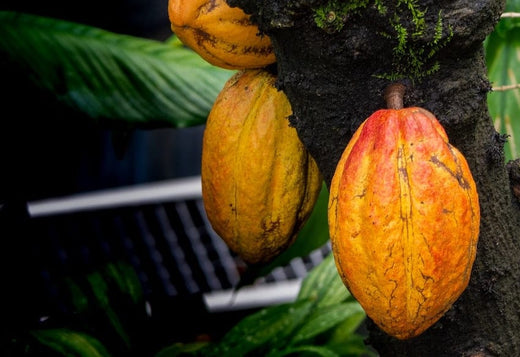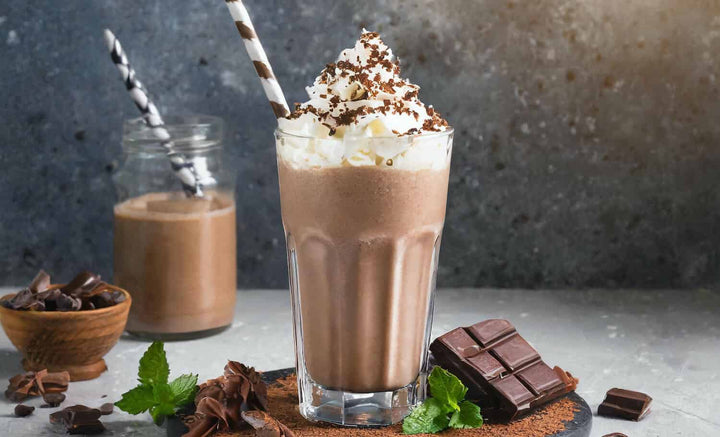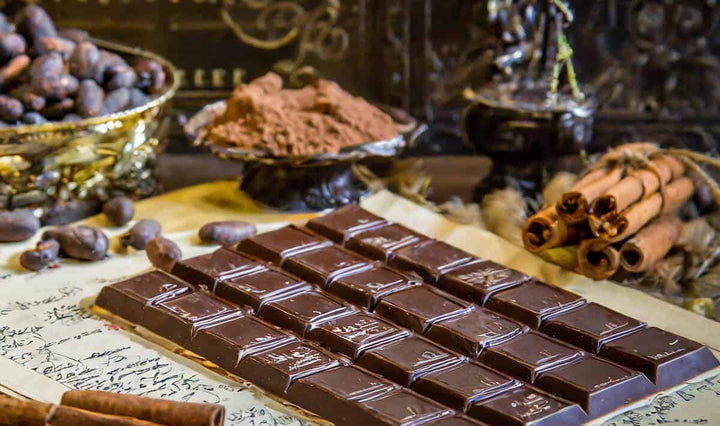Cacao fruit, the delightful gem that gifts us with chocolate, is a wonder of nature.
Not many people know that chocolate starts its journey on a tree as a large, colourful fruit.
Native to the Americas but now grown in many places across the globe, cacao has a history as rich and deep as your favourite dark chocolate.
Its journey from tree to treat is a fascinating one, with benefits and uses that extend beyond the beloved chocolate bar.
In this post, we will delve into the world of cacao fruit, exploring its history, cultivation, and the myriad of ways in which it can be enjoyed.
What is Cacao Fruit?
Cacao fruit is the pod-like fruit of the cacao tree (Theobroma cacao), which is native to the tropical regions of Central and South America.
The fruit is also commonly referred to as the cacao pod.
The cacao tree produces large, oval-shaped fruits that are coloured yellow, orange, or red when ripe.
Each fruit contains a sweet, white pulp that surrounds a cluster of seeds, commonly known as cacao beans.
These beans are the primary ingredient used to make chocolate and cocoa products.
The cacao fruit, including its pulp and beans, is highly nutritious and rich in antioxidants, vitamins, and minerals.
Though most famous for its role in chocolate production, the entire cacao fruit has a variety of culinary and health applications.
Related Post: What to Dip in Chocolate Fondue
Where Does Cacao Fruit Come From?
Cacao fruit comes from the cacao tree, Theobroma cacao, which is native to the tropical rainforests of Central and South America, particularly regions in present-day Colombia, Venezuela, and Ecuador.
However, due to the global demand for chocolate and other cacao products, the cultivation of cacao trees has spread to other tropical regions around the world.
Today, cacao is grown in a variety of countries across Central and South America, Africa, and Asia.
The main producers of cacao are Côte d'Ivoire, Ghana, and Indonesia.
These regions provide the ideal conditions for cacao cultivation: warm temperatures, high humidity, and regular rainfall.
Related Post: What Is Raw Cacao Powder?
What is Cacao Fruit Used For?
The most well-known use of cacao fruit is in the production of chocolate.
The seeds or cacao beans are fermented, dried, roasted, and then ground to produce cocoa mass or cocoa liquor, which is then processed further to make chocolate and other cocoa products.
However, cacao fruit has a variety of uses beyond chocolate:
-
Culinary Uses: The sweet white pulp surrounding the cacao beans can be eaten fresh or used to make juices, jams, and desserts. The cacao beans themselves can be ground to make cacao powder, which is used in baking and beverages.
-
Cosmetic Uses: Cacao butter, a fat extracted from cacao beans, is a common ingredient in cosmetics and skin care products due to its moisturising properties.
-
Medicinal Uses: Cacao is rich in antioxidants, particularly flavonoids, which are known for their anti-inflammatory and anti-oxidative properties. It has been used traditionally in various cultures for its potential health benefits, such as improving circulation, reducing the risk of heart disease, and boosting mood.
-
Beverages: The cacao beans can be used to make hot cocoa or chocolate milk. Cacao nibs, which are pieces of roasted cacao beans, can also be used to make tea or added to smoothies and other beverages for a chocolatey flavour.
It is worth noting that while the entire cacao fruit is edible and has various uses, the global demand for chocolate means that the majority of cacao beans are used for this purpose.
However, there is a growing interest in using other parts of the cacao fruit, and new products are being developed to use the pulp and the shell of the cacao beans.
Related Post: Health Benefits of Cacao Nibs
Can You Eat Raw Cacao Fruit?
Cacao fruit is edible in its raw state.
The fruit contains a sweet, white pulp surrounding the cacao beans, which is quite tasty and can be eaten fresh.
It has a sweet and tangy flavour, somewhat similar to a mix of lychee and mango.
However, the cacao beans themselves have a bitter taste when raw and are usually processed to make chocolate and other cocoa products.
If you are keen to try raw cacao, it's the pulp that you'll likely find the most palatable in its natural state.
It's worth noting that while the raw cacao beans are edible, they have a very different taste and texture compared to the chocolate that is made from them.
The process of fermenting, drying, and roasting the cacao beans transforms the flavour and makes it more palatable to most people.
Related Post: What Are Cacao Benefits for Health?
Can You Cook with Cacao Fruit?
Absolutely, you can cook with cacao fruit!
While cacao beans are commonly used to make chocolate and other cocoa products, the pulp of cacao fruit is also edible and can be used in a variety of culinary applications.
-
Juices and Smoothies: The sweet and tangy pulp can be blended to make juices or smoothies.
-
Sauces and Dressings: The pulp can be used as a base for sauces and dressings, adding a sweet and fruity flavour.
-
Desserts: The pulp can be used to make sorbets, ice creams, and other desserts.
-
Jams and Jellies: The pulp can be cooked down with sugar to make jams and jellies.
-
Baking: The cacao beans, after being processed into cacao powder, can be used in baking cakes, brownies, and other pastries.
Remember that the cacao beans themselves are quite bitter when raw, so they usually need to be fermented, dried, and roasted before being used in cooking or baking.
However, the pulp of the cacao fruit can be used in its raw state or cooked, depending on the recipe.
Also, cacao nibs, which are pieces of roasted cacao beans, can be used as a crunchy topping or ingredient in various dishes.
They add a rich, chocolatey flavour without the sweetness of regular chocolate.
What Does Cacao Fruit Taste Like?
The taste of cacao fruit is quite unique and not what you might expect, given that it is the source of chocolate.
The fruit is composed of the outer rind, the pulp, and the seeds or cacao beans.
-
Pulp: The pulp, also known as the mucilage, is the white, fleshy part that surrounds the cacao beans. It has a sweet, tangy, and slightly floral taste. Some people compare the taste of the pulp to a mix of lychee and mango or citrus fruits. It has a somewhat custardy texture and is the part of the cacao fruit that is most enjoyable to eat raw.
-
Cacao Beans: The cacao beans themselves have a bitter taste when raw. They do not taste like chocolate until they have been fermented, dried, roasted, and processed. Fermentation is essential as it develops the flavour precursors needed to create the chocolate flavour during roasting.
The cacao fruit offers a different taste experience than the chocolate made from its beans.
If you ever get the opportunity to taste fresh cacao fruit, it is definitely worth trying.
What is Wholefruit Chocolate?
Wholefruit chocolate is a type of chocolate made from the entire cacao fruit, including the beans and the pulp.
Traditional chocolate is made using only the cacao beans, while the pulp is often discarded or used for other purposes.
However, wholefruit chocolate uses the pulp to add natural sweetness and a fruity flavour to the chocolate.
The process of making whole-fruit chocolate involves fermenting the whole cacao fruit, drying the beans and pulp, and then processing them into chocolate.
This approach is more sustainable as it uses more of the fruit and reduces waste.
The resulting chocolate has a unique flavour profile, with the natural sweetness and fruity notes of the pulp complementing the rich, chocolatey flavour of the cacao beans.
Wholefruit chocolate is a relatively new product in the market and is being promoted as a more sustainable and innovative alternative to traditional chocolate.
It is part of a larger trend towards using whole cacao fruit and reducing waste in the cacao and chocolate industry.
Some Notes From an Expert Chocolatier
Creating chocolate is a fascinating and intricate process.
From the moment the cacao tree is planted to the time the chocolate is moulded and packaged, each step is crucial and demands meticulous attention and skill.
The art of chocolate making encompasses a multitude of stages: the fermentation of the cacao beans, drying and roasting them, and then meticulously grinding and conching the beans to create a smooth, luscious texture.
Each step requires precision and expertise, contributing to the final flavour, aroma, and texture of the chocolate.
A key aspect of making exquisite chocolate is using high-quality ingredients.
The quality of the cacao beans is paramount, and choosing the finest beans is essential to create a superior product.
At Whitakers, we understand the importance of quality and have always been committed to using the best ingredients to create our delicious chocolates.
Final Notes On What is Cacao Fruit
Cacao fruit is a fascinating and versatile ingredient that goes far beyond its most famous derivative, chocolate.
Native to the tropical regions of Central and South America, cacao has been cultivated and cherished for its unique flavour and potential health benefits for centuries.
The fruit itself consists of a sweet, tangy pulp that surrounds bitter cacao beans, which are processed to make chocolate and other cocoa products.
While the beans are most commonly used, the entire fruit is edible and offers a range of culinary possibilities, from juices and desserts to sauces and jams.
In recent years, there has been a growing interest in utilising more of the cacao fruit to reduce waste and create innovative new products.
Whether you are a chocolate connoisseur, a keen cook, or simply someone looking to explore new flavours, cacao fruit is definitely worth discovering.











